Rooftop pipe: correct installation
The most difficult thing in the matter of how to hold the pipe through the roof of a house can be called its waterproofing methods, that is, water from precipitation should not pass through the hole in the roof. There are various methods and devices for this, besides, a lot depends on the type of roofing material - its structure, texture and relief, and the cross section of the chimney or ventilation here is almost irrelevant.
Below we will analyze with you several options for such editing, as well as you can see a thematic demonstration of the video in this article.
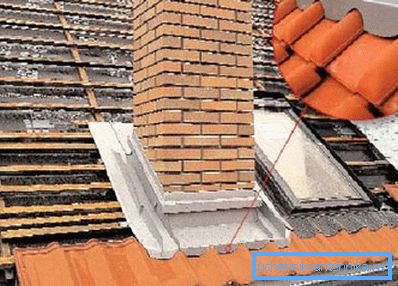
Connection methods
Note. The place of junction of the roofing material to the furnace or ventilation pipe can be called one of the most important nodes of the entire roof. The whole value of the roof as a waterproofing material depends on the correctness and quality of its installation.
General provisions

- To begin with, what is the usual expression, how to bypass the chimney on the roof is not quite correct, as this is the junction of the roofing material to the walls of the chimney or ventilation. The main task here is to ensure that the place of this very joint is very well sealed with some material in order to prevent water from entering the attic room.
- It’s not difficult to make a hole for the chimney with your own hands and it is usually cut with a grinder or roofing scissors - this can be done both during the installation of the roofing material and after it - it all depends on desire.. It is much more difficult to carry out the second moment - the junction itself with the help of an apron (it is most often made of galvanized tin), as well as the joint seal, where the function of the sealant can be performed by various silicones, as well as cement-sand mortar, tile glue and even bitumen.
- To accomplish such a task, the material with which the junction is carried out must correspond to the roofing material.. For example, for slate, the instruction recommends the use of galvanized tin and bitumen mastic, for a bitumen tile, an end carpet is needed, and for Ondulin - a material corresponding to its structure.
Adjacent to the metal roof
Now we will look at how to make an adjunction on the ramp if the furnace or ventilation pipe does not exceed 80 cm in width. Here we need to solve two main tasks, the first of which is to intercept water that will flow along the slope and redirect it over the roof, but already below the chimney (see also the Diameter and height of the pipe above the roof for ventilation).
But the second part of the task concerns the walls of the pipe itself, through which water flows down again - it also needs to be intercepted and redirected to the lower part of the ramp, preventing penetration into the attic.
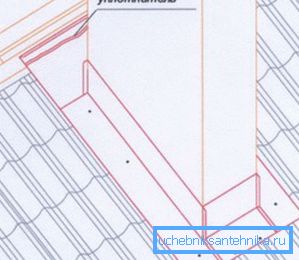
Now cutting the pipe on the roof will depend on the apron, which we need to make from galvanized sheet, and around the perimeter it should cover approximately 200-300 mm of roofing slope, and the turn on the chimney should be about 100-150 mm. Depending on the section of the chimney or duct, you can use sheets that correspond to GOST 14918-80 and have a thickness of 0.4 mm, where the perimeter will be either 10002000 mm, or 12502500 mm.
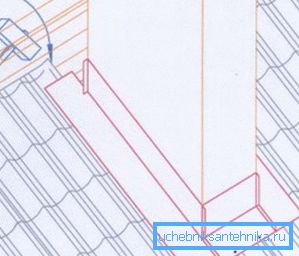
In this situation, it is important that the metal tile or decking be cut correctly, that is, the metal sheet should not rest against the pipe, which will cause its deformation and create conditions for water leaks, but at the same time, the gap should not be made too large 3-5 mm is enough.
When the apron is ready, you should take care of its sealing and for this you can use a special bitumen waterproofing, which you can buy in the store, but if its price seems too high, you can melt the usual resin.
You can, of course, just pour this resin under the apron at the junction points, but this is how you smear the roofing material that is nearby, therefore, you should arrange something like a gasket on which the metal apron will lie. Jute fabric is best suited for this purpose, that is, ordinary burlap from old jute bags.
From this fabric, the bedding and the sealing tape are cut out at the place where the metal joins the pipe, and after smearing it with hot resin, an apron is placed on top. While the resin will harden, you should use clamping strips, which can be made of any old slats.
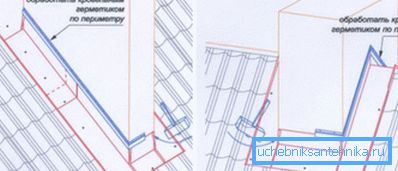
Very good, when the chimney or ventilation is located in the immediate vicinity of the ridge - so you get the opportunity to start the upper part of the apron under the ridge edge and thereby get rid of leaking. But the pipe can also be on a skate, which also makes the task somewhat easier, since the apron is located on both ramps, therefore, there is simply no leakage from above, because the water will spread on both sides of the apron.
Note. If necessary, the sheet metal is fixed to the chimney and roofing material using screws with a press washer.
Soft roof
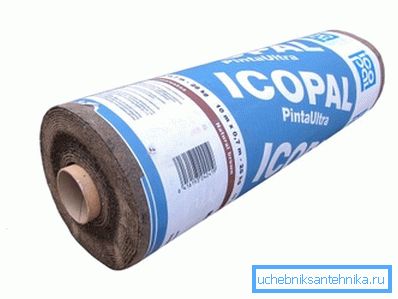
For a soft roof, for example, for shingles, two types of junction are used - open and closed, although the second option is used very rarely, as it is rather complicated to install and not quite practical to use, therefore, we will pay attention to the first method. In this situation, both the ventilation pipes on the roof and chimneys adjoin the roofing material on the same principle as the metal tile, that is, with the help of an apron and various kinds of sealants (see also the article Fittings for pipes: types and device).
Only for a soft roof, an apron is made not of metal, but of an end carpet that fits under shingles.

The principle of laying a soft apron is that the tile merges with it into one whole, and in the places where the roofing material adjoins the carpet there is no leakage, and the water should not flow into the attic room through the pipe, therefore, the carpet is chimneyed.
For fixation, various bitumen mastics are used here, but not all of them are justified - after one or another period of time, detachment occurs and then water penetrates through cracks.
Practice suggests that K-36 glue from Katepal is very well suited for this purpose, which serves for quite a long time and is not afraid of temperature fluctuations, ultraviolet radiation and moisture.
Note. There is one very important point here - it is adjacent to the carpet chimney - if adhesion with bitumen tiles is excellent, then this cannot be said of the brick wall of the chimney. Therefore, to create conditions for adhesion, the pipe at the junction is treated with a primer and give it the opportunity to dry completely.
Ondulin

For sealing joints on the roof covered with Ondulin, you can use branded materials such as Onduflash-super electrical tape and Ondulin cover apron. The principle of installation remains the same as for a soft or hard roof - here it is important to observe the sealing of the junction, as shown in the photo above.
Installation of the apron is carried out not only with the help of insulation tape, but also with self-tapping screws with a press washer, which fixes the apron to Ondulin (if necessary, you can also use different mastics or the same K-36 glue from Katepal).
Conclusion
By and large, pipe fittings on a roof made of slate, ondulin, metallic or soft coatings are made according to the same principle - the junction points must be tight not only on the horizontal, but also on the vertical plane (turning onto the pipe). In some cases, as the apron, especially for soft coatings, use roofing felt, laying it on the molten bitumen.